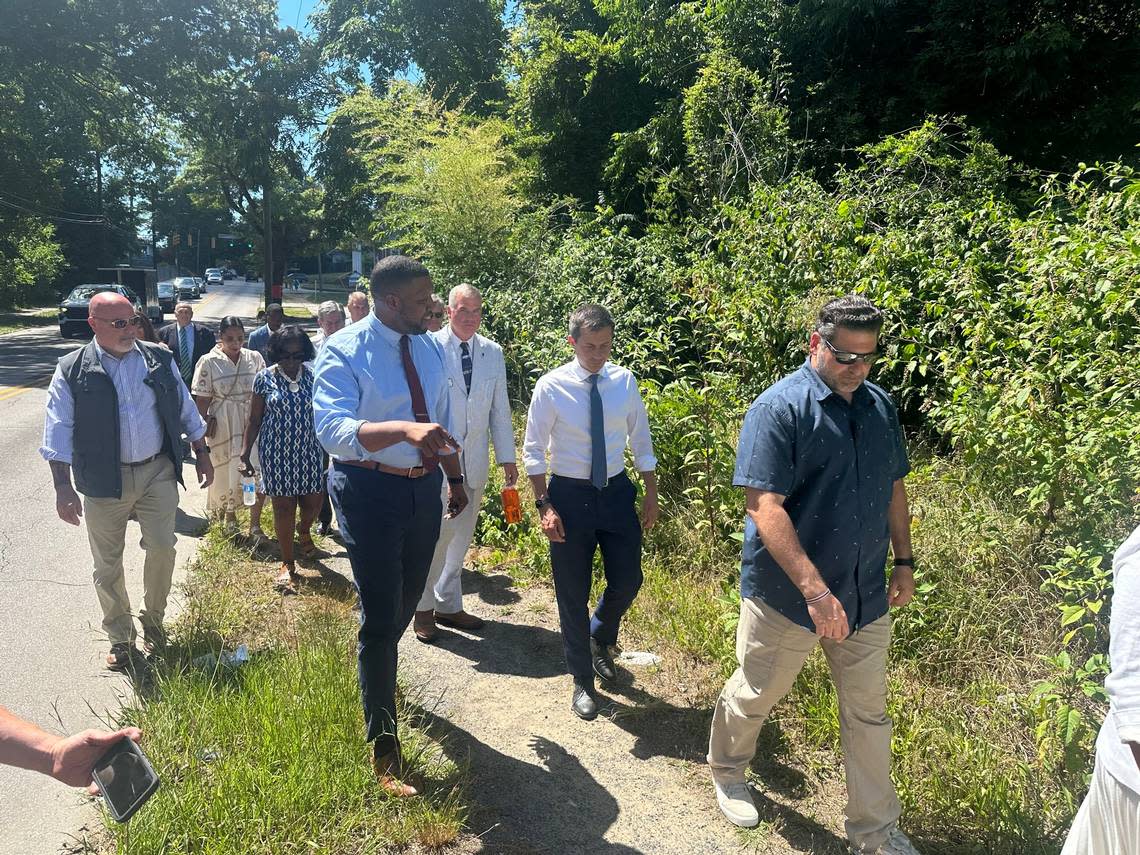Residents: Durham must address housing, other needs as it improves Holloway Street

U.S. Transportation Secretary Pete Buttigieg came to Holloway Street in Durham on Tuesday to see where the federal government plans to spend $12 million to help build new sidewalks, crosswalks and bus shelters.
Buttigieg walked with Gov. Roy Cooper and Mayor Leonardo Williams on a well-worn gravel path where a sidewalk should be. He visited a church, a barbershop and a food truck and spoke with a few residents along the way.
Along with praise for the federal help, Buttigieg heard concerns that it was not enough to help a low-income Black community that also needs help with jobs and affordable housing. Nishani Frazier, an N.C. State University history professor who lives in the neighborhood, told Buttigieg and Williams that improving the street alone could simply speed a process of gentrification that will displace long-time residents as property values rise and homes are replaced.
“So I’m not going to jump for joy until I see, along with breaking that concrete, affordable housing going up at the same time,” said Frazier, motioning toward the street from inside Cox Barber Shop.
Holloway Street, which stretches east from downtown past Interstate 885, is the city’s busiest bus route, a reflection of how much residents depend on GoDurham. The buses on Holloway average 3,291 passengers each weekday, or nearly 19% of GoDurham’s total ridership, according to the city.
Despite that, most of the bus stops are no more than street signs, and city officials acknowledge the network of crosswalks and sidewalks leading to those stops is incomplete. In five years ending in 2021, there were 46 crashes involving pedestrians along Holloway, resulting in three deaths and four serious injuries.
The $12 million federal grant will help the city provide shelters, benches, lights and bike racks at all 32 bus stops in a two-mile stretch of Holloway Street. The city also plans new, more visible crosswalks and upgrades to 33 intersections between Elizabeth Street and Junction Road.
The city will also fill in more than a mile of missing sidewalks, including the gravel path where Buttitieg, Cooper and Williams walked Tuesday.
“A lot of them are very short, less than one block,” Sean Egan, the city’s transportation director, said of the missing sections. “But it’s critical to have a fully connected, accessible network, so we’re going to be addressing every gap along the corridor.”
A historically neglected community
The sidewalk gaps are a symbol of under-investment in the community over the decades. Improving the street and the bus stops is overdue, said Camryn Smith, cofounder and executive director of Communities in Partnership, a nonprofit community development group.
“You need to do the work, because Black and brown communities deserve to have nice livable neighborhoods,” Smith said outside the church where Buttigieg, Cooper and Williams began their tour. “But there’s more to it.”
Like Frazier, Smith worries that improvements to Holloway Street will be enjoyed by new, wealthier residents who will displace those living in the East Durham and Albright neighborhoods now. Smith, who lives a block from the church, said that process has already begun.
“It’s a tale of two cities. While I’m standing here, I’m smelling urine, because where we’re at right now is where people who are chemically addicted and have mental health issues, this is where they hang out,” she said.
“But at the same time, you can walk two to three blocks and find a house that’s being built for half a million dollars. And if you go another two to three blocks, you’ll find they’re almost a million dollars.”
Buttigieg, the former mayor of South Bend, Indiana, said he understood the concerns about gentrification. He said the federal support includes money for community outreach and that his department seeks to work with local governments “that are intentional about how housing, transit and transportation all interact so that this supports the residents who are already here,” rather than push them out.
“I’m not here to say that it’s easy or anybody’s got it all figured out,” he told Frazier. “But I want you to know it’s on our mind.”
Williams also acknowledged that residents could be leery about new sidewalks and bus stops just as the area appears to be changing. He said the city needs to do more to help residents remain in the neighborhood.
“Instead of displacement, or what some folks call gentrification, this is revitalization,” he said. “And this investment that we have here is only part of the puzzle.”
The city expects to finish designing the changes to Holloway Street next year, begin acquiring right-of-way in 2026 and complete construction by the end of 2027, Egan said. In addition to the $12 million federal grant, the city will kick in $3 million.


